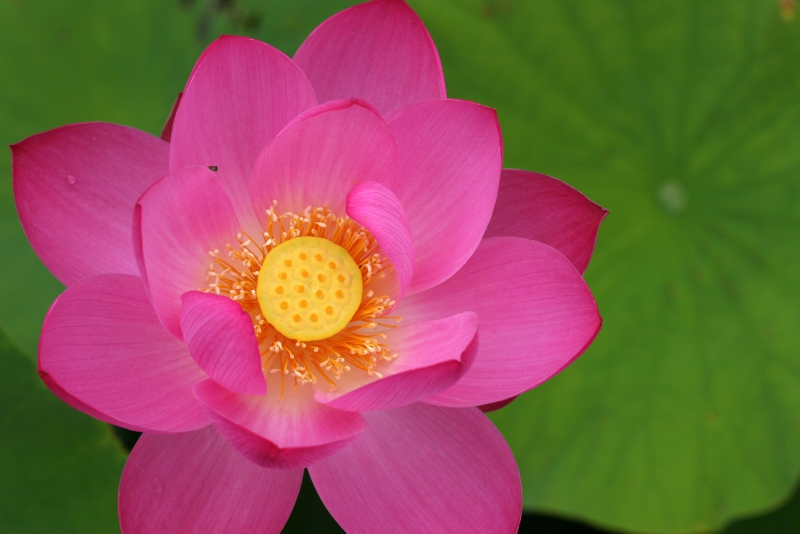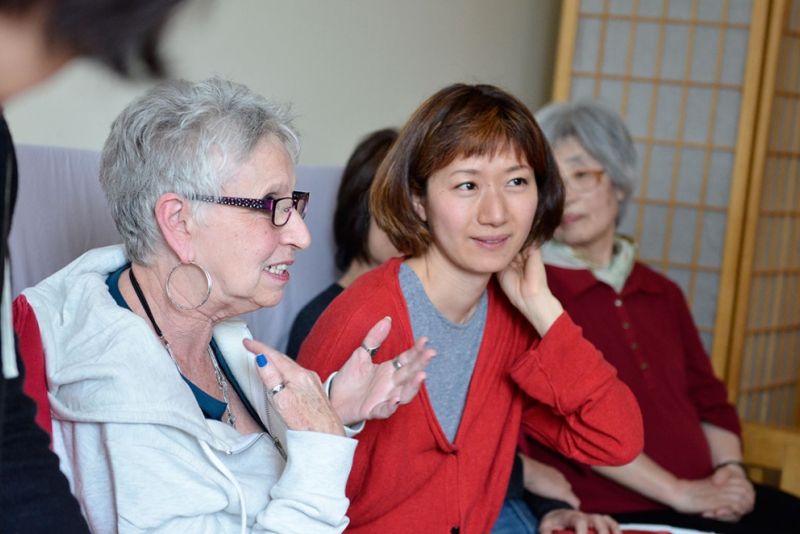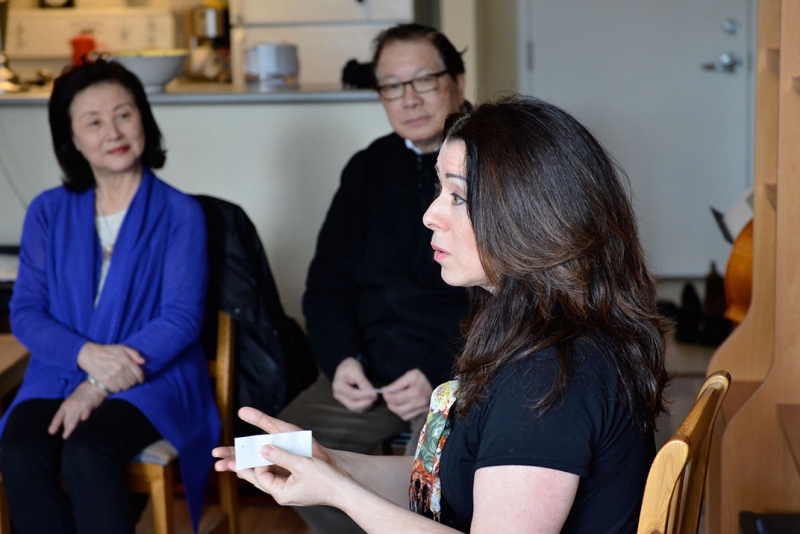Buddhism: A Philosophy of Life
Daily Practice
The practice of chanting Nam-myoho-renge-kyo was established by Nichiren (1222-82), a reformist Buddhist monk who identified the Lotus Sutra as the core teaching of Shakyamuni Buddha.
Applying the Teachings
Practice is supported by faith and study. SGI members study the teachings of Nichiren in order to deepen their understanding of the principles of Buddhism and the processes of inner transformation. Study strengthens faith and conviction, which finds expression in practice.
Faith, in Nichiren Buddhism, is grounded in the experience of applying Buddhism and seeing improvements in the quality of one's life. Faith could be described as the ongoing effort to orient one's heart toward the ideal of Buddhahood—the continual unfolding of one's inherent potential for good, the ability to transform any negative circumstance into a source of growth and benefit, and a life dedicated toward helping others do the same.
As a tool to help practitioners in this challenging process, Nichiren created a mandala known as the Gohonzon (object of devotion)—a scroll inscribed with Chinese and Sanskrit characters which SGI members enshrine in their homes and focus on when chanting. The Gohonzon is a physical embodiment or representation of the ideal of Buddhahood. The characters on the Gohonzon depict the "Ceremony in the Air" as described in the Lotus Sutra. At this ceremony, the Bodhisattvas of the Earth vow to lead people to happiness during the most tumultuous of times. Gongyo is an act of renewing this determination.
Discussion Meetings
SGI practitioners carry out their daily practice at home, but also meet regularly with other members in their communities. The discussion meeting tradition dates back to the earliest days of the Soka Gakkai's history in prewar Japan, and serves as the focal point for practitioners to study Buddhist principles and how to apply them in everyday life.
SGI discussion meetings are usually held on a monthly basis, and the vast majority are held in the homes of practitioners who make them available for this purpose. They give people the opportunity to develop the kind of relationships that are increasingly rare in contemporary urban environments where people may live for years as neighbours without developing any personal connection.
The sharing of faith experiences—the transformation in people's lives realized through Buddhist practice—is a central element of discussion meetings. There is perhaps nothing more heartening for people struggling with problems than the example of others who have successfully confronted and overcome their own challenges.
Human Revolution
A key concept in the SGI is "human revolution"—the idea that the inner transformation of an individual will cause a positive change in one's circumstances and ultimately in society as a whole.
Such transformation comes about through tackling the challenges of daily life with Buddhist practice, seeking to develop one's potential and taking responsibility for one's life and destiny. Change on a global scale comes about through a positive change in individuals.
SGI practitioners believe that each individual has the power to develop a life of great value and creativity and to positively influence their community, society and the world. Nichiren Buddhism stresses that the greatest fulfillment in life is found ultimately in working for the happiness of others.
Nam-myoho-renge-kyo
Nichiren (1222-82) established the chanting of Nam-myoho-renge-kyo as the way to awaken one's Buddha nature and tap into the deepest levels of our existence, on which our own lives and that of the universe are one. He first taught the invocation of the phrase to a small group at Seicho-ji temple in Awa province, Japan, on April 28, 1253.
Myoho-renge-kyo is the name of the Lotus Sutra in Japanese pronunciation of classical Chinese characters, and so the literal meaning of Nam-myoho-renge-kyo is "I devote myself to the Lotus Sutra." As the following explanation shows, there are deeper levels of meaning attached to each element of the phrase.
Nam
Nam derives from the Sanskrit word namu, meaning "to devote oneself." Nichiren established the practice of chanting Nam-myoho-renge-kyo as a means to enable all people to put their lives in harmony or rhythm with the law of life, or Dharma. In the original Sanskrit, namu indicates the elements of action and attitude, and refers therefore to the correct action one needs to take and the attitude one needs to develop in order to attain Buddhahood in this lifetime.
Myoho
Myoho literally means the Mystic Law—the underlying truth or principle which governs the mysterious workings of the universe and our life from moment to moment. Myo refers to the very essence of life, which is "invisible" and beyond intellectual understanding. This essence always expresses itself in a tangible form (ho) that can be apprehended by the senses. Phenomena (ho) are changeable, but pervading all such phenomena is a constant reality known as myo. Myo also means to open, to revive, and to be fully endowed with the qualities we need to develop our lives.
Renge
Renge means lotus flower. The lotus blooms and produces seeds at the same time, and thus represents the simultaneity of cause and effect. The circumstances and quality of our individual lives are determined by the causes and effects, both good and bad, that we accumulate (through our thoughts, words and actions) at each moment. This is called our "karma." The law of cause and effect affirms that we each have personal responsibility for our own destiny. We create our destiny and we have the power to change it. The most powerful positive cause we can make is to chant Nam-myoho-renge-kyo; the effect of Buddhahood is simultaneously created in the depths of our life and will definitely manifest in time.
The lotus flower grows and blooms in a muddy pond, and yet remains pristine and free from any defilement, symbolizing the emergence of Buddhahood from within the life of an ordinary person in the midst of the struggles of day-to-day existence.
Kyo
Kyo literally means sutra, the voice or teaching of a Buddha. In this sense, it also means sound, rhythm or vibration. In a broad sense, kyo conveys the concept that all things in the universe are a manifestation of the Mystic Law.
Read More: The Meaning of Nam-myoho-renge-kyo
The Gohonzon
The object of devotion in Nichiren Buddhism, called the Gohonzon, takes the form of a scroll inscribed with Chinese and Sanskrit characters. SGI practitioners receive their own Gohonzon that they enshrine in their homes and which they focus on when they chant.
The significance of the Gohonzon lies not in the literal meaning of the characters, but in the fact that it is was created by Nichiren as the physical embodiment, in the form of a mandala, of the eternal and intrinsic law of Nam-myoho-renge-kyo. The phrase "Nam-myoho-renge-kyo Nichiren" is written in bold characters down the centre of the scroll.
Nichiren inscribed the Gohonzon with the purpose of helping any person, regardless of gender, race or status, experience the same enlightened state of being that he had attained.
The Gohonzon is an embodiment of the Buddha state that exists within every one of us. However, for most of us, this state remains an unrealized potential; it is latent but needs to be "activated." Through daily practice in front of the Gohonzon we can reveal that latent Buddha nature. The Gohonzon is in a sense like a spiritual exercise machine—through using it we develop our lives; simply possessing it is not enough.
Nichiren encourages us, "when you chant myoho and recite renge, you must summon up deep faith that Myoho-renge-kyo is your life itself" (The Writings of Nichiren Daishonin, vol. 1, p.3). Nichiren teaches us, in other words, that one's life is the greatest treasure.
Our inner life-condition changes constantly as we come into contact with different external stimuli: people, the weather, a piece of music, the colour of the walls. . . all create some kind of influence on us. A painting can cause the viewer to feel enraptured, calm or disgusted, and a letter can cause joy or shock and dismay. The Gohonzon is the stimulus that helps us draw forth this most enlightened state of life, perceive the Buddha state as the true nature of our life, and live in harmony with our environment.
To convey his message, Nichiren based the graphic image of the Gohonzon on a scene from the Lotus Sutra and on the theory of the mutual possession of the Ten Worlds, which expresses that the world of Buddhahood exists as a potentiality in any given moment or life-condition of an individual. In other words, the world of Buddhahood does not lie outside of one's daily existence or being—it is inherent in one's life.
The large characters "Nam-myoho-renge-kyo" down the centre of the Gohonzon depict this realization. To the left and right of "Nam-myoho-renge-kyo," written in smaller characters, are various figures that represent the Ten Worlds in the life of the Buddha. Nichiren graphically indicated that all ten worlds are illuminated by Nam-myoho-renge-kyo, or the Mystic Law, and are contained within the world of Buddhahood and vice versa.
Simply stated, all beings are Buddhas. It is just a matter of awakening to this realization and living in a way that manifests this truth. In Nichiren Buddhism, chanting to the Gohonzon and taking action for the sake of others is the way to achieve this.
Courtesy of www.sokaglobal.org









